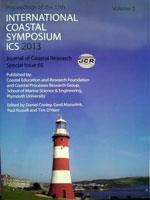Colenutt, A., Mason, T., Cocuccio, A., Kinnear, R. and Parker, D., 2013. Nearshore high resolution substrate and marine habitat mapping to inform marine policy and coastal management.
The Defra-funded National Network of Regional Coastal Monitoring Programmes of England, through collaboration with the Maritime and Coastguard Agency's Civil Hydrography Programme, are increasingly utilising cost-effective technology to achieve 100% seafloor coverage to International Hydrographic Organization (IHO) Order 1a standard, of the nearshore zone from about Mean Low Water Springs to approximately 1km offshore. Detailed specifications have been developed to ensure efficient acquisition of swath bathymetric data that are accurate, repeatable, maximise interoperability and are made freely available. Analysis of seabed substrate and habitat maps, which identify zones of exposed bedrock and surficial deposits of coarse, fine and mixed sediments, provide spatial detail of seabed features, such as sand waves, rock outcrops, pinnacles and scour and provide baseline conditions for monitoring of marine ecosystems. Interpretation and production of marine geology maps may also provide important information about seafloor composition and structure, physical properties and sedimentological and geological processes such as natural hazards. The methodology developed for data processing and interpretation combined with examples from a suite of detailed indicative substrate and marine habitat maps is presented. Interpretation of the full coverage swath bathymetry and acoustic backscatter information and ground-truthing data enables high resolution marine-related spatial and temporal substrate whilst habitat maps provide a sound multi-disciplinary scientific evidence base to inform development of European and UK marine environmental policy and planning, and are valuable tools for managing the sustainable use and conservation of coastal and marine resources, thus aiding the integration of terrestrial and marine planning regimes.





